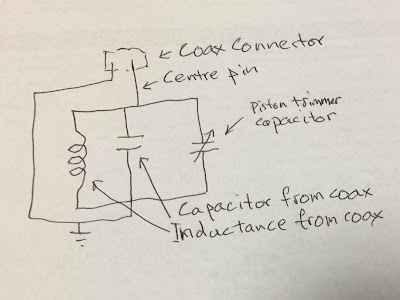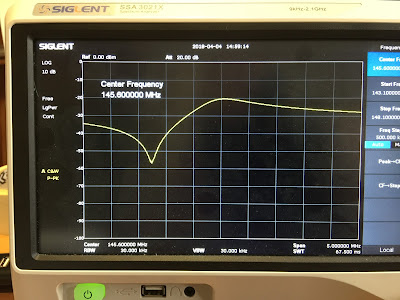DIY 2m single connector pass reject coupling
DIY 2m single connector pass-reject coupling
Introduction
In my last post I describe the repair and tuning of a high performance 2 m duplexer that uses an unusual single connector pass-reject coupling. In this post I describe how to make one for about $30 that achieves the same level of performance.First, I explain what seems to be the theory of the pass-reject coupling as a parallel tuned circuit, using the coax as the inductor and part of the capacitor. The coax conductor is the other part. The variable piston capacitor is in parallel with the coax capacitor to allow tuning. It also gives the necessary mirroring for RX and TX responses.
Then I describe how I made one that achieves about the same performance as the original.
I am very pleased as I have been working on DIY pass-reject couplers for some time. It allows the construction of a complete high performance, six cavity VHF duplexer for about $300, less the cost of connectors and cabling.
Theory of the tuned coupling
The coupling is a pass-reject type using a parallel tuned circuit, DC from coax connector to earth. Looking at the centre pin, it is connected to the shield of the coax and the conductor is earthed, then the coax is bent into the coupling shape. At the other end, the shield is not terminated but the the conductor is connected to earth. This is a tuned circuit, with the shield both an inductor and part of a capacitor. The capacitor is from the capacitance of the coax at 98 pF per metre. The piston capacitor (1-10 pF) is in parallel with the coupling capacitance, allowing tuning.The coupling is similar, but the reverse of a magnetic loop antenna. In a magnetic loop antenna, the antenna loop is the tuned circuit and the coupling an un-tuned loop to couple the RX/TX coax to the tuned loop; a transformer. In the cavity filter, both the resonator and coupling are tuned, explaining the pass and the reject. The resonator determines the pass frequency and the coupling the reject frequency, which is how they are tuned. Resonator first for the pass, then the capacitor reject.
The TX coupling is shorter and tunes to a higher frequency, not clear why.
The mirroring comes from the adjustment of the trimmer. more gives RX shape, pass then reject, whereas less gives the TX shape, reject then pass. Not sure why this occurs, some interaction with the resonator I suppose.
The Q of the resonator, cavity and coupling determines the depth of the notch. The Q is high, in the order of 2000 to 5000.
The base of the resonator, effectively a quarter-wave antenna is primarily a magnetic field, whereas the other end, electrical. Being near the base, the coupling is magnetic, as per an air-cored transformer.
Pass-reject couplings are particularly good as they give high out of band rejection as well very sharp pass and reject for RX and TX.
Effective circuit, ignoring resistances.
Process
As with other coupling construction, as I have describe a careful drawing is made of the commercial coupling on grid paper. In this case, I just drew the outline with the coupling sitting flat on the paper. The coax sizes are drawn too big, but my coupling just needs to fit inside the drawing.The first photo shows my copy and the commercial coupling, the second, the paper tracing.
Materials
The biggest problem was getting a minimum 32 mm disk for the base of the coupling. I couldn't think of how to make them; the hole is not in the middle. Then I thought of getting them made on a lathe; expensive. But then I thought laterally. The first was to use large coins that could be soldered. The 1966 Australian 50 cents is 32 x 2 mm and 80% silver; so I ordered some at $10 each. Then I tried searching eBay; stamped brass blanks were available locally at about $1 each; a bit thin at 1.2 mm but 32 mm diameter is ok. They arrived first and I used them.The coax is semi-rigid RG402 copper tube shied, PTFE and silver/copper/steel inner, available from Element 14 at $20 per m.
I had some piston capistors. They are available on eBay from "element 13" in Bulgaria, or from usual suppliers at high prices. 1-14 pF is ok.
Making
The holes are drilled with a step bit in a drill press. A Dremel or similar is useful for cutting/sanding/stripping.I extended the centre pin by slipping on a piece of the coax shield to give more length. Bending the coax is easy with the right diameter dowel. Soldered the coax to the pin, cut the other end to length soldered it to the capacitor and pin again.
Tuning
Checked it would tune to the same frequency as the original and tried it in the cavity; top wasn't perfect fit but it is to go into another cavity anyway. Very close to the original in performance, even with the 1600 MHz split; excellent.Original coupling
Copy; near identical. Low loss and high reject.
Mirroring from adjusting the trimmer capacitor
Free air resonance
Conclusion
After many attempts at an easy to build pass-reject coupling, finally success. The couplings are for a fairly big tuning range, so dimensions are not too critical.I will build a copy of the shorter TX coupling and see if it performs in a similar manner. To a point, the one I have made can act as RX or TX by adjusting the trimmer.








Thank you for doing the write up. I have copied the Telewave loop a few times. But I have never taken the time to make drawings. I have recently built for 6M BPBR duplexers using this design. The cavities are Telewave cavities I cut do to size for 6M.
ReplyDeleteI do have a question in your hand drawn drawing you show the TX loop as 115mm and the RX Loop is 152mm. Is this correct?
Hi. Thanks for the comment. Yes, they are those sizes. I was a bit surprised too but it is the way they came. I lay the coupling on the paper and traced around it.
DeleteI am currently working on an Australian UHF CB duplexer that has a 750 kHz split, so may try the design for it.
Drew VK4ZXI
Hi Drew must try this coupling loop technique looks good !! I have got heaps of hardline and piston caps, so will try it !
ReplyDeleteinterested in the prs duplexer project ...... 750Khz is a tight squeeze !! have you tried 3/4 wavelength filters for better performance ??
got a few repeater projects on my scruffy website regards Mike zl1btb
http://www.amalgamate2000.com/radio-hobbies/radio/Index.htm